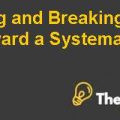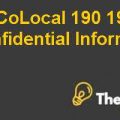
Overview/Critique of Initial Growth Strategy
Starbucks the home to re-creation, the Italian espresso bar experience was founded in 1987 by Howard Schultz in the United States, who wanted to build a personal relationship between coffee and consumers. Within a short span of time, the company grew from a small business into a market leader in the industry of specialty coffee. The fundamental vision of Howard Schultz for the company was to make "romance with coffee". Similar to the Italian coffee bars, he needed a place where the customers could have an association with the coffee and coffee bars. He sensed the social aspect of the coffee and believed that this could make a connection between the Starbucks and its customers if done in a right manner. The coffee consumption trend has moved down since 1960 therefore, Starbucks positioned itself with a great care and extreme cautious. The company chose its target market on the basis of potential market factors such as political, social, competitive and environmental factors. As the proposed price of one cup of coffee was $1.50, so the target market of the Starbucks were the people with middle to high income. The aim of the Schultz was to make Starbucks a “Third Place” after home and office where people could enjoy spending time with friends. The company used an undifferentiated targeting strategy as they targeted the entire market as a single segment. For marketing, Schultz used relationship marketing as his main objective was to build strong relationship with customers to compel them to visit Starbucks regularly. The company positioned itself as the premium coffee provider with the help of superior quality, premium services and innovation. For their superior quality and unique experience, Starbucks charged a premium price however; they justified it by delivering high value to its customers. The evidence of the success of the Starbucks is its rapid growth in its initial years, it opened 15 new stores in fiscal year 1988, 20 in 1989, 30 in 1990, 31 in 1991, and 53 in 1992. (See exhibit 1 for Strategic Alliance of Starbucks with its vision over time).
Now the question is where the Starbucks went wrong? The way that Starbuck's had multiplied its speed of growth while they were already growing rapidly, had changed the profile of customers, and additionally the brand discernment. Starbucks distracted from its visions and instead of building a relationship with customers, it focused on fast and quick growth solutions. The company increased its growth activities in order to please Wall Street, which changed the style of its operations, its brand image and its marketing preferences. In order to improve efficiency and reduce costs, Starbucks changed its mind and had introduced machines in their stores which greatly affected the customer experience. Starbucks distracted from its vision and turned to another chain instead of becoming a unique destination. This change greatly affected its marketing styles and its positioning from a premium coffee café to an ordinary food chain with lots of other items together with a range of coffee. Although, Starbucks got exposure to a number of regions and expanded the numbers of stores, widely recognized and admired by the customers consistent with the Schultz’s vision of espresso bars, but it had also faced certain consequences and challenges because of a shift in competitive environment and difficulty in economy.
Strategic Plan
In February 2007, Schultz questioned the path of the Starbucks growth because the company lost the “romance of Theatre” of coffee making. For the purpose, Schultz lowered the price of their products to $1 and offered free refills, ran TV advertisements to attract customers, and he had also planned to bring back the lost experience, charm and brand image of the Starbucks. Though, the planning to bring back the lost charm and premium quality of the Starbucks is a good option because the key reason behind the challenging and weak condition is that the company distracted from its key visions, which lost its uniqueness and made it an ordinary fast food chain. It is clear that Schultz has discovered the roots of its losses and challenges therefore, he should once again work to bring back the lost touch and relationship of the company with its customers. I believe, that the company should avoid pleasing the Wall Street and focus only on their customers because customers are their main asset and they can only please Wall Street by pleasing their customers. The strategic transform should be done in the following three phases......................
This is just a sample partial case solution. Please place the order on the website to order your own originally done case solution.
After going public in 1992, a strong balance of Starbucks' list and double-digit growth made it a hot stock growth. Starbucks coffee was a vision of culture as a community, the third place between work and home, where friends shared their experiences and exotic languages gourmet coffee. Its growth has been fueled rapid growth in the number of stores in both the United States and in foreign markets, the addition of auto-service, its own music label, which promoted and sold CDs in stores and other ancillary sales, including pastries and sandwiches. In a remarkably short time, Starbucks has become wildly successful global brand. But in 2007, the performance of Starbucks' slipped, the company reported a first-ever decline in customer visits to U.S. stores, which led to a 50 percent drop in the share price. In January 2008, the board ousted CEO Jim Donald and brought Howard Schultz - a visionary leader Starbucks' and CEO from 1987 to 2000 and current chairman and chief global strategist - again take the helm. Strategy Starbucks' growth were widely reported and analyzed, but rarely face to their impact on the brand. This case offers a compelling example of how the "non-brand" management solutions - such as store locations, licensing agreements and auto services - it may make sense for the financial criteria at a time, but destroy the brand positioning and equity in the long term. study of the growth decisions in the United States provides a rich context in which to consider the promise and the lack of further international expansion. "Hide
Lauranne by Buchanan, Carolyn J. Simmons Source: Richard Ivey School of Business Foundation 14 pages. Publication Date: January 22, 2009. Prod. # 909A02-PDF-ENG













